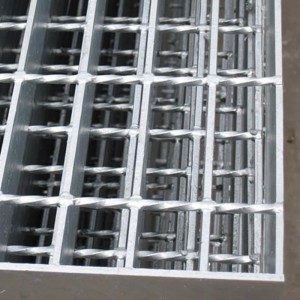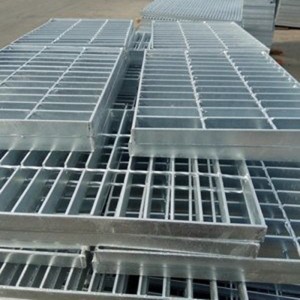The steel grating structure is adapted to the needs of various purposes. It has been widely used in industrial workshops in industries such as smelters, steel rolling mills, chemical industry, mining industry and power plants as floor platforms, platforms, sidewalks, stair steps, etc. The steel grating consists of longitudinal gratings and transverse bars. The former bears the load, and the latter connects the former into a grid-like whole. According to the connection method and process characteristics of the grating and the bars, the steel grating is divided into several types.
Pressure welded steel grating
Pressure welded grating is made of longitudinal load-bearing gratings and transverse twisted square steel, with the help of welding power supply above 2000KV and 100t pressure. The manufacturing width is 1000mm. Its load-bearing grating has no punching holes (i.e., it is not weakened). The nodes in the longitudinal and transverse directions are welded point by point. The welds are smooth and slag-free, thus forming a grid with 600 to 1000 firm connection nodes per square meter, which has uniform light transmission and air permeability. Since the welding point has no slag, it has good adhesion to paint or galvanized layer, as shown in Figure 1. The T-joint between its end grid and the load-bearing grid is connected by CO2 gas shielded welding.
Embedded pressure welded steel grating
It consists of a load-bearing grid with a punched hole and a transverse grid without a punched hole. The transverse grid is embedded in the load-bearing grid, and then the pressure welding machine is used to weld each node. Since it is similar to the previous grid structure, but the transverse grid is a plate, its section modulus is greater than that of twisted square steel, so it has a higher load-bearing capacity than the previous grid.
The load-bearing shed of the pressed steel grating plate is slotted for the connection of the bars. The slot is sickle-shaped. The sickle-shaped slots of the adjacent load-bearing grating plates are bent in opposite directions. The unweakened transverse bars are pushed into the slots of the load-bearing grating plates with high pressure by a special press. Since the slots are bent in opposite directions, the transverse bars are added with an additional dimension, which increases the rigidity of the grating plate. Therefore, the load-bearing grating plates and the transverse bars are inextricably connected to each other, forming a strong grating plate that can resist horizontal shear force and has great torsional rigidity, so that it can withstand a large load. The T-shaped node between the end edge plate of the pressed grating plate and the load-bearing grating plate is welded with CO2 gas shielded welding.
Plug-in steel grating plate This type of grating plate has a slender slot on the load-bearing grating plate. The bars are inserted into the slots and rotated to form a vertical and horizontal grid in the notch. The end edge plate of the load-bearing grating plate is welded with the load-bearing grating plate by CO2 gas shielded welding. In addition, the bars are reinforced with blocks after being fixed. This type of grating plate has been mass-produced in China. Its advantages are simple assembly and less welding workload, but its load-bearing capacity is not high, so it can only be used as a light grating plate.


Sawtooth special grating plate When there are special anti-skid requirements for the grating plate, such as inclined sidewalks with ice, snow or oil, a sawtooth special grating plate can be used. This type of grating plate has two types: ordinary and special. Its load-bearing grating plate is a slat with serrations. The transverse grating bars are the same as those of the pressure-welded grating plate, which are twisted square steels that are pressure-welded on the load-bearing grating plate. When the user needs it, in order to prevent a 15mm diameter ball or other objects of similar size from passing through the gap, one or more threaded steel bars can be pressure-welded between adjacent load-bearing grating plates under the transverse grating bars (twisted square steel). The difference between the ordinary type serrated grating plate and the special type grating plate is that the ordinary type of transverse grating bars are welded to the upper end of the serrations of the load-bearing grating plate. In this way, the footprints of people only contact the transverse bars (Figure 5a), while the special-shaped transverse bars are welded to the trough of the sawtooth of the load-bearing grid plate, so that the footprints of people will contact the sawtooth (Figure 5b). Therefore, the special type has greater anti-slip resistance than the ordinary type. Compared with the ordinary type, the latter has 45% greater anti-slip ability in the transverse bar direction than the former.
Regardless of the type, because it is a grid connection of the grid plate and the bars, it has excellent anti-slip performance and strong bearing capacity. In addition, its finished products have no gaps and no punching holes. If the surface is given galvanized protection measures, its corrosion resistance and wear resistance are far superior to other metal decking. In addition, its good light transmission and air permeability also determine that it is suitable for a variety of occasions.
Post time: Jun-19-2024
